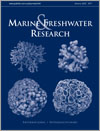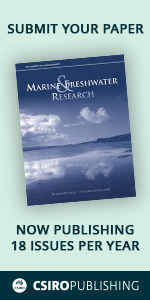Marine and Freshwater Research
Volume 68
Number 3 2017
In this paper we propose eight principles that form a heuristic framework to navigate the interface between river science and river policy. These principles were qualitatively evaluated against the objectives of the Australian Water Act 2007 and specifically, the draft Murray–Darling Basin Plan; a component of the Act. We examine whether the eight principles of river science could be recognised in the design of the Water Act 2007 and the draft Basin Plan.
Rhodolith beds are major marine benthic algal communities, comparable in size and significance to kelp beds, seagrass meadows and coralline reefs. Our study indicated that rhodoliths (free-living coralline red algae) are common throughout 70% of Australia’s coastline, forming a vast natural resource in terms of area covered, biodiversity and carbonate production.
The zooplankton of lakes can consume basal carbon sources originated in aquatic and terrestrial habitats and, it plays an important link between these sources and organisms in higher trophic levels such as fish. Using stable isotopes analyses, we showed that in a productive tropical lake, the reliance of mesozooplankton on basal carbon sources seems to follow the seasonal dynamics of in-lake primary production (algae) and terrestrial carbon (plant) inputs.
Food web studies help us understand how ecosystems work. In wetlands of the Kimberley region of north-west Australia we found that microscopic algae is a major source of food for aquatic animals. Groundwater inputs to some waterholes were enough to allow waterholes to persist throughout the dry season. Using groundwater for development may affect the ecological and cultural value of freshwater wetlands through reducing permanence and altering foodwebs.
The present research has demonstrated how population structure differs in elasmobranchs with different patterns of habitat use. The dwarf and green sawfishes, which spend their entire life in marine waters, were found to have restricted gene flow in Australian waters. In contrast, the largetooth sawfish, which uses freshwater rivers as juveniles and marine waters as adults, was found to have male-biased dispersal in these waters.
The present study provides the first length-at-age, growth and maturity estimates for the bronze whaler (Carcharhinus brachyurus) from Australian waters. Growth-model parameters combined with reproductive information identified C. brachyurus to be long-lived, slow growing and late maturing. These life-history characteristics highlight the potential vulnerability of C. brachyurus to anthropogenic impacts.
The present study demonstrated that fish abundance was up to threefold higher and species richness twofold higher on artificial structures compared with the natural habitat on a tropical estuary. In addition, fish trophic structure from an adjacent coral reef area showed more than 60% similarity with the fish community on the artificial structures surveyed.
The present study describes the food web and trophic relationships of a macroinvertebrate assemblage of a permanent Mediterranean river during the four seasons of the year. Moreover, a quantitative approach to estimate the link strength was developed and applied. Finally, relationships between diversity (biological and functional) and food-web complexity are then analysed with the distribution of strong and weak links, and their permanence over time, identified.
We tested the separate and combined effects of altered flow and fines on macroinvertebrates. Sedimentation and decreased flows individually decreased density and richness of macroinvertebrates and altered assemblage and trait structure. Higher flows did not ameliorate any effects of sedimentation. Further research is required to find the lowest thresholds of sedimentation that have ecological impacts and determine the flows required to ameliorate those impacts.
In Mediterranean shallow lakes, there is a primary effect of external nutrient loads and temperature on eutrophication. However, in these lakes, both senescence and the removal of aquatic plants strongly affects nutrient dynamics, and the amount of the external nutrient load determines the recovery of the lake once nutrient discharges cease.
This study shows that small changes in riparian forest complexity affect the composition of Ephemeroptera, Plecoptera and Trichoptera insects across a small environmental gradient in subtropical streams. The genera Kempnyia (Plecoptera) and Zelusia (Ephemeroptera) were indicative of streams with greater forest complexity, whereas Farrodes (Ephemeroptera) was significant in streams of intermediate riparian forest complexity.
Acoustic methods were used to investigate diel and seasonal fish distributions and biomass in a shallow Tunisian reservoir. Gas bubbles confounded spring and summer surveys; bubbles were rare and fish were distributed in open water at night during autumn and winter. Introduced carp, not targeted by fishers, were predominant. Advice on controlling carp to promote a desired fishery is offered.
Spatial and temporal patterns of meiofaunal diversity in a Neotropical lotic ecosystem were investigated. Local and among-areas scales were the highest contributors to overall richness, suggesting local species aggregation and environmental variability as drivers of meiofauna diversity. Temporal diversity was aggregated primarily at the monthly scale. The differences among areas contributed to changes in community composition. Degradation levels and precipitation affected meiofaunal abundance and structure.
Stable isotopes were used to investigate the role of submerged aquatic plants (macrophytes) in agricultural stream food webs. Macrophytes made moderate contribution to food webs, but the contribution of macrophytes and their epiphytes was higher where riparian zones were degraded. Many macroinvertebrates were generalist feeders, so these resources may compensate for lost riparian vegetation food inputs in degraded streams.
Two types of tags were evaluated in the holothuroid Holothuria grisea: an external T-bar and a passive integrated transponder (PIT) tag. Neither the T-bar nor the PIT tags fulfilled the requirements of high retention required for long-term studies. However, we do recommend the use of T-bars for short-term studies for H. grisea under low complexity conditions.
The study used cameras dropped from boats to examine fish populations in and around a small marine reserve in Tasmania, to assess their potential as a monitoring tool. The study found that fish populations differed depending on location, depth and bait, with fish abundance increasing significantly with depth. The research validated the use of underwater cameras for monitoring deep reefs.
The importance of submerged aquatic vegetation (SAV) beds, dominated by seagrass, as a habitat for shrimp in relation to their distance to a tidal inlet was evaluated in a subtropical coastal lagoon (Laguna Madre of Tamaulipas, Mexico). The SAV bed located 1 km from the inlet had consistently higher shrimp abundance during the day and night, whereas the distant SAV bed (25 km from the inlet) was apparently limited by recruitment, resulting in low shrimp densities.
We interviewed local fishermen and conducted a fishing survey, so as to assess presence and abundance of bull sharks in the Navua River in Fiji. Both the interviews and the fishing survey confirmed the presence of young sharks. Our findings provide a preliminary characterisation of a potential shark parturition or nursery area from a data-poor region.




